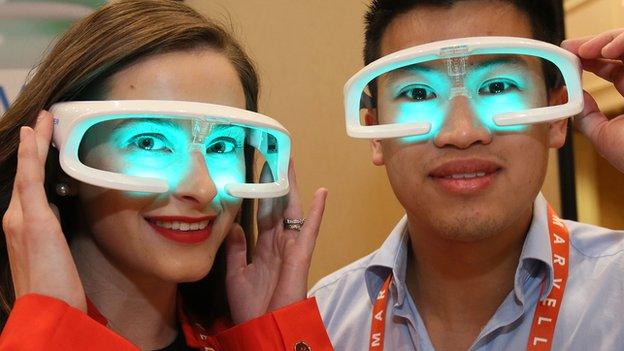CES 2014: Fun run puts tech to the test on Vegas strip
- Published
BBC News gets a sneak preview of some of the wearable fitness gadgets that will be on show at CES 2014
Las Vegas may be in the middle of the desert but at 08:30 PST on a January morning it does get pretty chilly.
That nip in the air left a group of runners, including me, shivering as we gathered prior to setting out on a short 10km (6.2 miles) sojourn along the city's main thoroughfare.
All of us were in town for the 2014 Consumer Electronics Show (CES). So, why were we going running? Three reasons, really.
Scratch a runner and underneath you will more than likely find a geek who has more than an average interest in the stats and numbers their hobby and body generate.
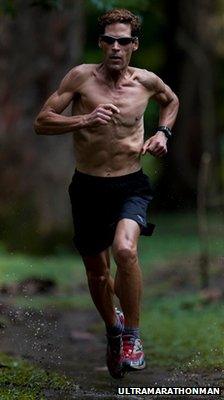
Dean Karnazes uses a fitness tracker to log data about his runs
Plus lots of tech journalists are runners, as are many of the folks that peddle fitness tech. The run was a great way to get the two groups together away from the vast generic halls of the Las Vegas Convention Center.
Finally, wearable technology is a big theme at CES this year, and amateur sportsmen and women have been pioneers for this sort of portable hi-tech.
Marathon man
The tech the average runner now sports has filtered down from elite athletes such as Dean Karnazes, who joined the 25 runners for the early morning trot.
Even among long-distance runners, Mr Karnazes is a phenomenon who enjoys such extreme reserves of stamina that he regularly gets up early to complete a marathon before taking his kids to school.
He's in no doubt that tech helps him achieve such feats of endurance.
"One device I use is a Fitbit Force to track foot turnover," he says.
"I do this to monitor running efficiency and tempo, in an effort to improve endurance."
The distances he covers mean his use of tech is a little more extreme than the average pavement plodder like me.
For instance, rather than use mapping apps and websites to plot a course round his neighbourhood he is more likely to use it to ensure that a cross-continental run does not go astray.
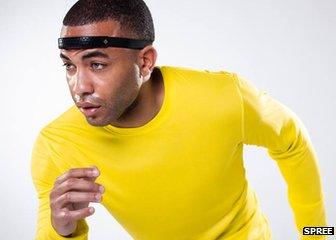
Spree Sports are at CES with a headband that tracks body temperature, heart rate and movement
Despite the differences, there is an affinity among runners no matter their ground speed or modest goals.
Their geekish nature means that many wear a GPS watch to track the exact distance they travelled, calories expended, and whether they hit the times needed to get a PB (Personal Best).
Beneath their hi-tech running tops many will also be girdled with a heart monitor to ensure their run is done at a pace that gets the organ pumping at its optimum level.
Hospital tech
The innovation that brought these hi-tech gadgets out of labs and medical settings - where they first found use - is still continuing, and CES 2014 will see the debut of some novel devices to help smooth the training of both amateur and elite athletes.
Prototypes on view include a headband produced by Spree Sports that gathers data about heart rate, core body temperature and other physiological indicators through sensors touching the forehead.

Some of the participants in the inaugural CES fitness tech fun run
Hi-tech firms Mio and Basis use watches to do a similar job.
All three have adapted technology used to monitor heart rates and blood-oxygen levels in hospital patients with light.
There are also fledgling projects to use smart spectacles as fitness aids.
For example, Strava is one of the apps due to be included with every pair of Google Glass spectacles when they ship. Strava spokesman Jordan Kobert says beaming data onto the Glass's lens will make it easier for runners and other sportsmen and women get feedback about their workout.
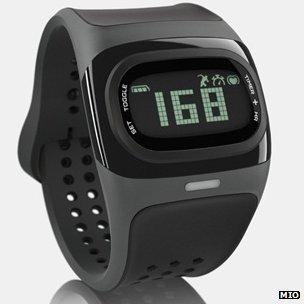
The Mio Alpha contains a heart rate monitor that links to compatible smartphones via Bluetooth
"There's lots of promise there," says Mr Karnazes who is talking to another tech firm about developing a Glass-like headset specifically for running and cycling that would track key measures such as time, speed and distance.
Experimental age
Ben Wood, head of research at consultancy CCS Insight, says the technology is at a key inflection point in its development.
"Wearable tech right now reminds me of mobile technology in the mid '80s," he says.
"Back then there was great experimentation as to which end of a phone the send and end keys went."
That is why wearable tech comes in so many varieties at the show. No-one is entirely clear which form-factor will win out.
Though, Mr Wood adds, it is likely that those which link social networks with their gadgets will do well. Being able to show your fellow runners that they can eat your dust is a great motivator.
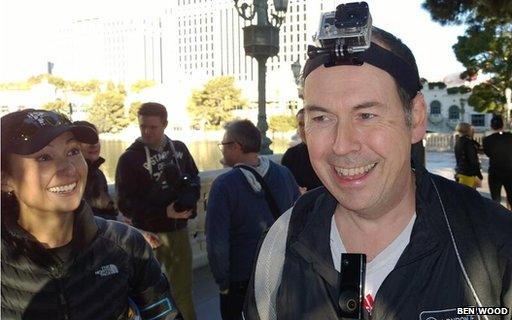
BBC technology correspondent Rory Cellan-Jones came fully-equipped for the run
It's likely that smartphones will be at the centre of the rapid growth of wearable tech, says Shawn DuBravac, chief economist at the Consumer Electronics Association which organises CES.
The huge success of the smartphone over the last few years made it much easier for peripheral devices such as fitness and activity trackers to prosper.
"Despite this," he adds, "it's a nascent market where we are still looking for what that killer application is for these kinds of devices."
Only human
If the enthusiasm for tech among the runners who took part in the 10km run on Sunday or the sheer amount of wearable tech on show at CES is any guide then that killer app is not far away.
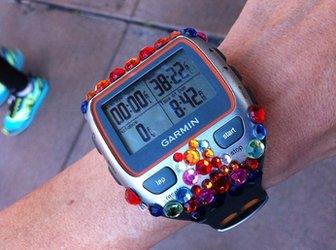
Race participant Kathy Johnson has customised her Garmin Forerunner fitness tracker
Then again, when it comes to running or any sporting endeavour, setting a PB or finishing a tough race is about more than just bits, bytes and battery life.
"Tech is a terrific tool and can help you train and prepare but ultimately it's up to you to get the job done," says Mr Karnazes. He has only managed to cover superhuman distances thanks to his bloody-minded determination to see the task through.
And that human side of running should never be forgotten, agrees running veteran Tim Kelly of the Las Vegas Running Club who drew up the route for the fun run and helped organise the event.
"I don't use any technology," he says. The only tool he takes along on a run is a band to hold back his long hair.
"I just step outside my front door and get going."
- Published6 January 2014

- Published5 January 2014
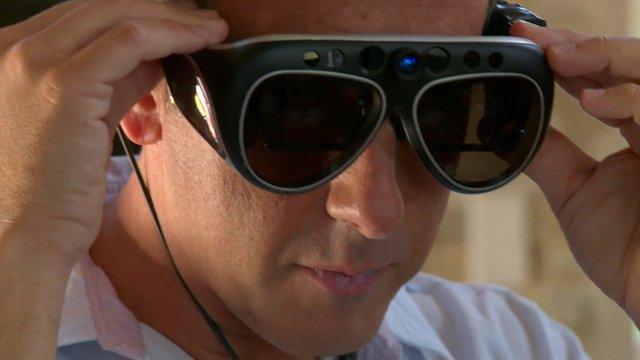
- Published3 January 2014
